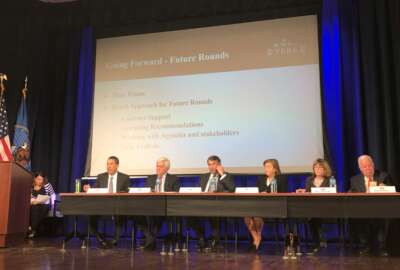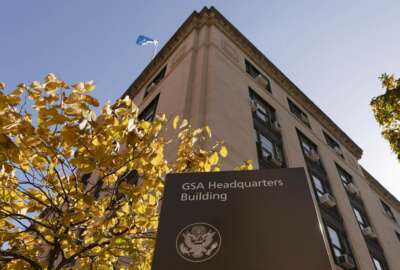

An independent agency created to fast-track the sale of excess federal properties is falling behind on its goals envisioned more than six years ago, and is running...
An independent agency created to fast-track the sale of excess federal properties is falling behind on its goals envisioned more than six years ago, and is running into many of the bureaucratic hurdles it was meant to bypass.
The Public Buildings Reform Board, created under the 2016 Federal Assets Sale and Transfer Act (FASTA). recommended in January 2020 that the General Services Administration sell a dozen “high-value,” but underutilized federal properties.
GSA sold 10 of those properties for $194 million, well below the board’s sales target of $500-$700 million, according to reports from the Government Accountability Office.
The board expected its following round of recommendations in December 2021, once sold by GSA, would bring in about $2.5 billion in total proceeds, but the Office of Management and Budget rejected the board’s list in its entirety.
Two members of the board resigned last year after OMB rejected its proposals, leaving the board without a quorum for nearly all of 2022.
The COVID-19 pandemic and the federal workforce’s shift to mandatory telework gave agencies an opportunity to rethink their office space needs.
But with the Biden administration focused on bringing more federal employees back to the office, it remains unclear if PBRB missed its window to offload underutilized office space, or how close the board will reach its financial targets before it sunsets in May 2025.
Former Rep. Nick Rahall (D-W.Va.), a member of the PBRB, told the Senate Homeland Security and Governmental Affairs Committee that the two remaining properties from the board’s high-value asset list could bring in $100-300 million in proceeds if sold.
But Rahall said it’s taken GSA years to prepare the final two properties for sale, “losing the market momentum and positioning these large assets to be so squarely in a commercial real estate downturn.”
“The length of time to sell these properties will likely cost the government hundreds of millions of dollars, if not billions, when considering the cost savings over the next 30 years,” Rahall said.
David Marroni, GAO’s acting director of physical infrastructure said the board saw “significant setbacks” in its first two rounds of its recommendations.
“FASTA is effectively a six-year experiment to try and mitigate some of these challenges, by testing out new concepts and different ways of disposing of unneeded real property. This experiment has not gone wholly as planned,” Marroni said.
Proceeds from the high-value asset recommendations were meant to help PBRB prepare subsequent rounds of properties for sale and disposal. But delays in selling the high-value properties, combined with OMB completely blocking the sale of its second round of properties, has given the board few resources to continue its work.
“The funding that was expected to be available to help prepare disposal wasn’t available. This led to limited recommendations, and then ultimately the termination of the second round,” Marroni said.
PBRB regained a quorum in November 2022, and is preparing its final round of recommendations.
Rahall said the board expects its final round of recommendations, if sold, could bring in up to $4.75 billion in proceeds.
Nina Albert, the commissioner of GSA’s Public Buildings Service, said PBRB under FASTA increased the number of properties available for sale and disposal, “but only by a small margin,” and that the board has not reduced the timeline to offload federal property to another owner.
GSA, meanwhile, showing some progress in shrinking the federal government’s real estate portfolio.
Albert said GSA over the past five years, has consolidated federally leased office space, reducing that space by 13 million square feet, and reducing costs by $6.5 billion. GSA, she added, also shrank its portfolio of federally owned office space by about 13 million square feet over the same period.
“We are implementing today and still the necessary consolidation actions that were planned pre-pandemic,” Albert said.
Rahall said the board, as part of its final round of recommendations, is working with agencies on consolidating leased office space. The board, he added, is conducting its own review of federal properties in several key metropolitan areas.
Agencies are supposed to report excess and underutilized property through the Federal Real Property Profile (FRPP), but Rahall said this data is about two years old and doesn’t reflect current conditions.
Agencies in fiscal 2021 reported nearly 900 federal buildings as underutilized, and that nearly 8,000 government facilities remained completely unused.
“Certainly we need data to conduct our recommendations — data that we just don’t have night now,” Rahall said.
Sen. James Lankford (R-Okla.) expressed frustration that agencies have failed to live up to FASTA’s goals, and that the federal government hasn’t offloaded more excess property.
“We can’t even get a data list of even the properties out there we own to be able to have that list to be able to know what we have, much less know how to be able to manage it from here,” Lankford said.
Committee Chairman Gary Peters (D-Mich.) said maintaining these unused or underutilized spaces costs taxpayers money and makes the federal government vulnerable to wasteful spending.
“The federal government’s property needs are evolving, and we should ensure that buildings the government operates both meet the needs of the agencies and are also cost-effective for taxpayers,” Peters said.
The federal workforce’s shift to mandatory telework during the pandemic put a spotlight on the amount of federal space agencies require.
The pandemic, Albert added, also set into motion other workforce trends, including demand for increased amenities and higher-quality space, in order to recruit and retain employees. She said the pandemic also led to a focus on air quality and “smart building improvements” that include occupancy monitoring.
“The federal buildings portfolio not only needs to be optimized, it also needs to be modernized, so the agencies can better deliver their missions,” Albert said.
OMB issued a memo in April calling on agencies to “substantially increase meaningful in-person work at federal offices,” particularly at the headquarters level.
The Department of Veterans Affairs announced in May it will bring employees in the National Capital Region back to the office at least five days every two-week pay period, starting this fall.
“We’re going to continue over the next year, I would say, to understand where that pendulum is finally going to rest,” Albert said, regarding agencies’ future-of-work plans. “As an asset manager and property and portfolio manager, I don’t need to wait completely for a final answer. But agencies, before they’re willing to give up space, will want to have a better understanding of how they plan to operate.”
GSA, in its fiscal 2024 budget request, is looking to regain full access to the Federal Buildings Fund. The agency hasn’t had full access to the fund, which contains rent payments from tenant agencies, for more than a decade.
Without full access to those funds, Albert said GSA has had to defer repairs and upgrades to federal buildings. She said eight of the 17 major repairs and alterations projects in GSA’s 2023 budget were resubmissions from the prior year’s request.
Albert said GSA has $11.3 billion less in appropriations than the revenues it has collected, “which directly contributes to deteriorating building conditions, which leads to underutilization.”
Albert said agencies that underutilize federally owned property are forced to lease additional space, which drives up overall government spending on office space.
Copyright © 2025 Federal News Network. All rights reserved. This website is not intended for users located within the European Economic Area.
Jory Heckman is a reporter at Federal News Network covering U.S. Postal Service, IRS, big data and technology issues.
Follow @jheckmanWFED



